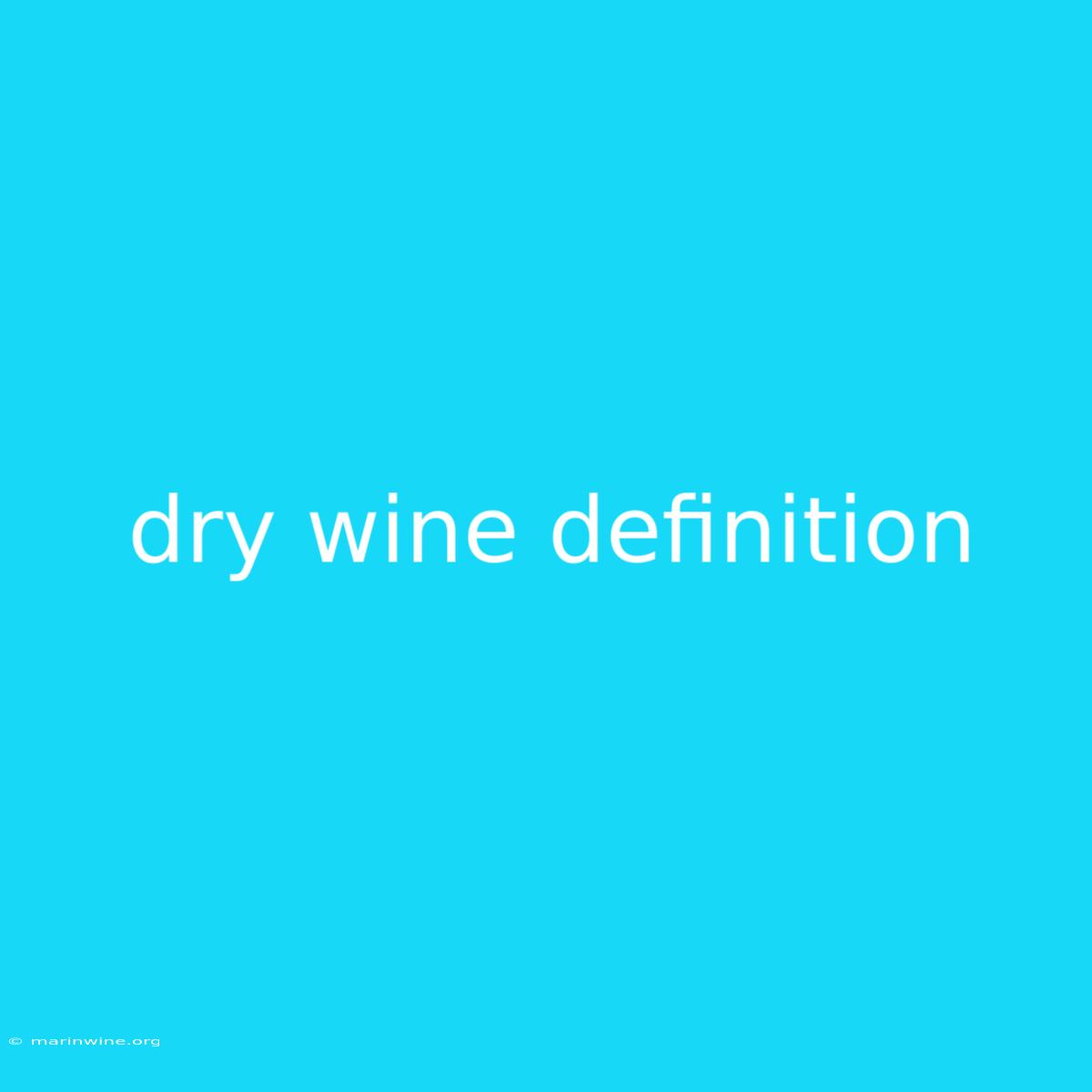What Exactly is Dry Wine? Unraveling the Secrets of a Flavorful World
Have you ever wondered what makes a wine "dry?" It's more than just the absence of sweetness. This seemingly simple question reveals a world of complexity in the world of wine.
Why It Matters: Understanding the concept of "dry" wine is crucial for anyone who enjoys or wants to learn more about wine. It helps you navigate the world of labels, appreciate the nuances of flavor, and choose wines that suit your taste.
Key Takeaways of Dry Wine:
| Key Takeaway | Description |
|---|---|
| Dry Wine: Low Sugar Content | Dry wines have minimal residual sugar after fermentation. |
| Dry Wine: Not "Sweet" | "Dry" doesn't mean the wine is flavorless. It simply indicates the absence of sweetness. |
| Dry Wine: Wide Range of Flavors | Dry wines can be bold, complex, and offer a wide range of flavor profiles. |
| Dry Wine: Food Pairing Potential | Dry wines excel at pairing with a variety of foods, enhancing and complementing flavors. |
Let's delve deeper into the world of dry wine:
Dry Wine Definition
Dry wine is a term used to describe wines that have a low residual sugar content. This means that most of the sugar in the grapes has been converted to alcohol during the fermentation process. The result is a wine that is not sweet, but rather exhibits a range of flavors that are often described as "crisp," "clean," "dry," or "refreshing."
Key Aspects of Dry Wine
1. Fermentation: The key factor in determining a wine's dryness is the extent of fermentation. During fermentation, yeast consumes sugar in the grape juice and produces alcohol and carbon dioxide. In dry wine production, fermentation is allowed to proceed until almost all the sugar is consumed.
2. Residual Sugar: The small amount of sugar remaining in dry wines is known as residual sugar. This residual sugar level is typically less than 1 gram per liter. This minute amount of sugar does not contribute significantly to sweetness, but it can add complexity and depth to the wine's flavor profile.
3. Dry Wine Styles: Dry wines are produced in a wide variety of styles and regions. Some popular examples include:
- Red Wines: Cabernet Sauvignon, Pinot Noir, Merlot, Zinfandel
- White Wines: Sauvignon Blanc, Chardonnay, Riesling (dry styles), Pinot Grigio
- Rosé Wines: Dry rosés are increasingly popular and offer a refreshing and versatile option.
4. Taste Profile: Dry wines can have a wide range of flavor profiles depending on the grape variety, winemaking techniques, and region. Some common flavor descriptors include:
- Acidity: Dry wines often exhibit a refreshing acidity that balances the flavors and creates a crisp, clean taste.
- Tannins: Red dry wines often have tannins, which contribute to a sense of structure and complexity.
- Fruit Flavors: Dry wines can showcase a range of fruit flavors, from citrus and green apple to black cherry and blackberry.
- Earthy Notes: Some dry wines may have earthy or mineral notes that add complexity and depth to their flavor profile.
Dry Wine: A Versatile Choice
Dry wines are incredibly versatile and pair well with a wide variety of foods. They can be enjoyed on their own or paired with everything from appetizers and salads to hearty entrees and desserts.
- Red Dry Wine Pairings: Red dry wines pair well with red meats, grilled vegetables, rich cheeses, and hearty pasta dishes.
- White Dry Wine Pairings: White dry wines pair well with seafood, chicken, salads, and lighter pasta dishes.
- Rosé Wine Pairings: Rosés are known for their versatility and pair well with a wide range of dishes, from light salads to grilled chicken and seafood.
FAQ
Q: How can I tell if a wine is dry?
A: The wine label will usually indicate the dryness of the wine. Look for terms like "dry," "brut," or "extra-dry."
Q: What are some examples of dry wines?
A: Dry wines are found in a wide range of styles and regions. Some examples include Sauvignon Blanc, Chardonnay (oaked or unoaked), Pinot Noir, and Cabernet Sauvignon.
Q: Is all dry wine the same?
A: No, dry wines can vary significantly in taste and style. Factors like grape variety, region, and winemaking techniques all contribute to the final flavor profile.
Q: Is dry wine better than sweet wine?
A: There is no "better" choice; it depends on your personal preference. Some people enjoy the refreshing taste of dry wine, while others prefer the sweetness of dessert wines.
Q: Can I enjoy dry wine if I don't like sweet wines?
A: Absolutely! Dry wines have a wide range of flavors and can be enjoyed by those who prefer non-sweet wines. Experiment with different styles and regions to find wines you enjoy.
Tips for Enjoying Dry Wine
- Start with a taste: Take a small sip and let the wine linger on your tongue for a few seconds to fully appreciate its flavor.
- Pay attention to the aroma: Dry wines can offer a wide range of aromas, from floral and fruity to herbal and earthy.
- Pair with food: Dry wines can complement a wide variety of dishes, enhancing the flavors of your meal.
- Store properly: Store dry wine in a cool, dark place to preserve its quality.
Summary of Dry Wine
Dry wines offer a refreshing and complex world of flavor, with a wide range of styles and regions to explore. By understanding the definition of dry wine and exploring the key aspects that influence its taste, you can navigate the world of wine with confidence and discover wines that you love.

